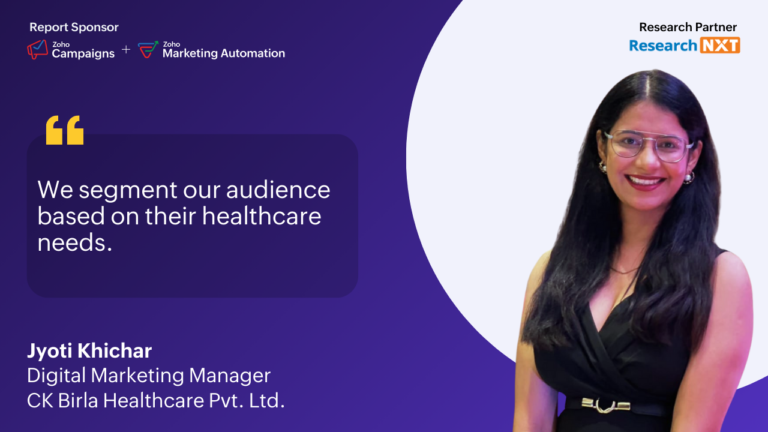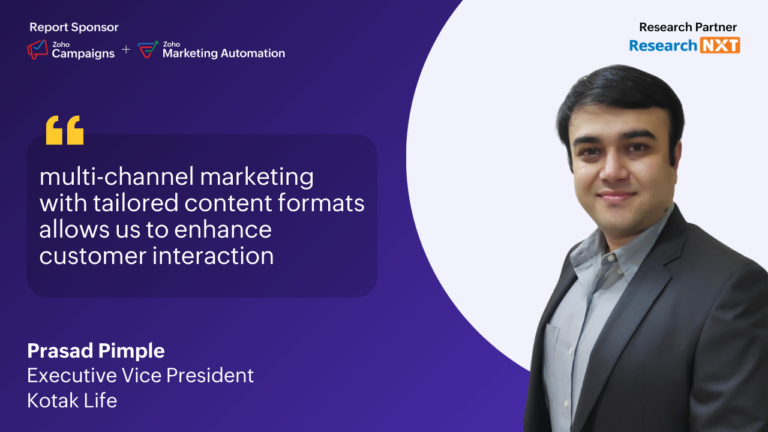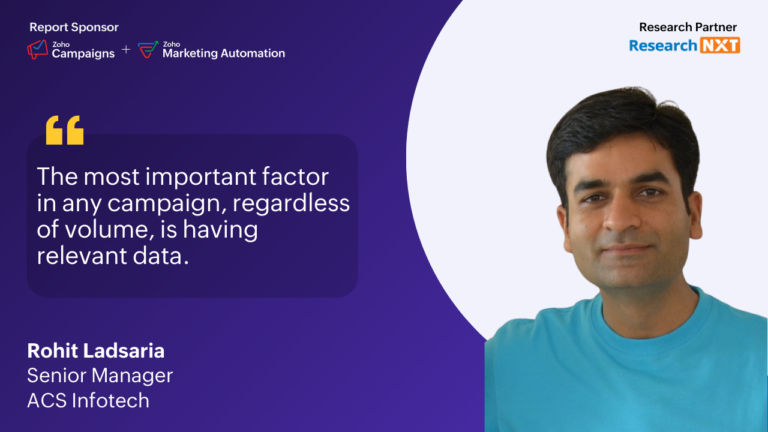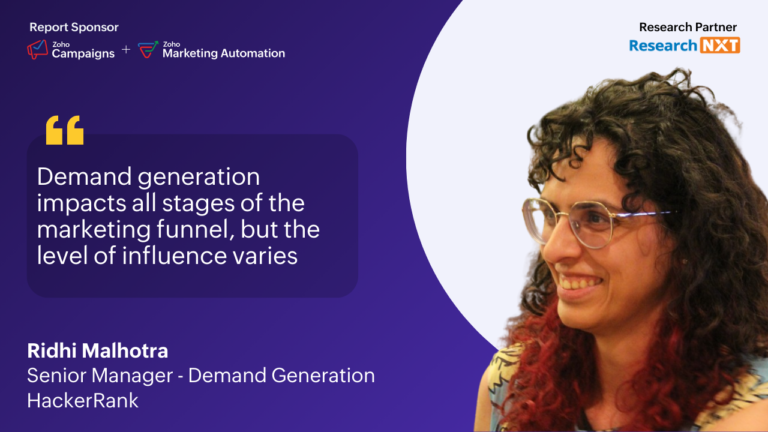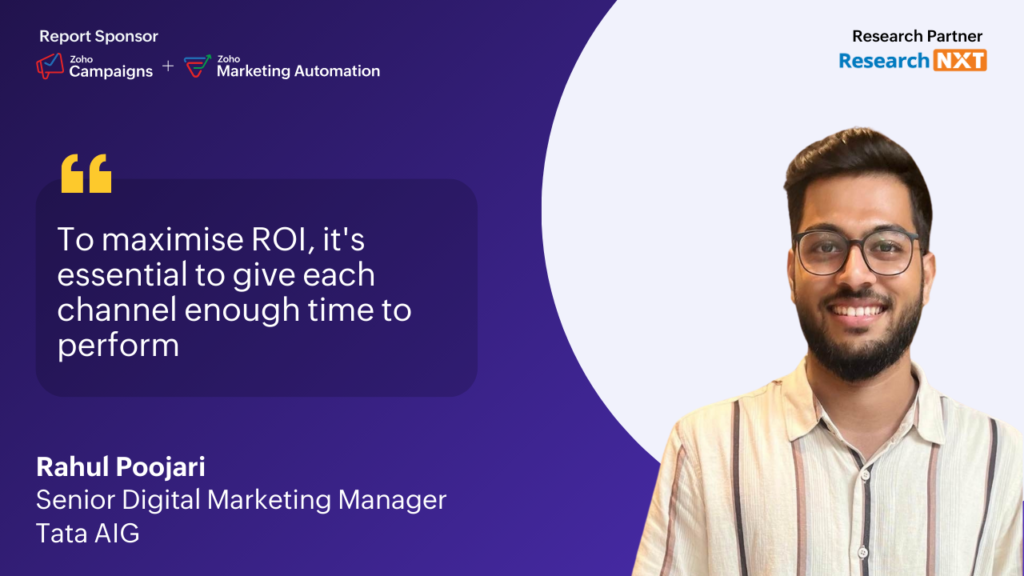
How accurate attribution of channels is crucial for determining campaign budgets and effectively reaching customers
In this Research NXT Interview, Rahul Poojari, Senior Marketing Manager at Tata AIG, discusses his journey within the organisation, the opportunities to understand customer pain points to sell successfully, and the crucial role of analytics in multi-channel campaign management.
Key takeaways from this Research NXT interview:
- The primary channels that Rahul and his team focus on for effectively reaching potential customers.
- The significance of promptly assisting customers with their health insurance needs in real-time to prevent potential loss of leads.
- The crucial role that attribution plays in deciding the flexibility in budgeting, allowing for the allocation of funds to the most effective channels and withdrawing funds from underperforming ones.
"Touch base with multiple channels help the customers to maintain contact with potential customers and encouraging their return."
We’d like to know about your role and journey at Tata AIG. Given your expertise in creating and implementing digital marketing campaigns, we would love to hear about your career path, the campaigns you have developed, the processes you have worked on, and current role at Tata AIG.
Rahul: Currently, I manage the health insurance Digital Business at Tata AIG, where my primary focus is driving revenue via various digital channels. My role involves not only boosting revenue but also deeply understanding our customers and their pain points.
My overall journey has spanned both the agency and brand sides of the business. On the agency side, I gained insights into identifying the perfect mix of channels for reaching customers effectively. Transitioning to the brand side, I focused on understanding customer pain points, which is crucial for successfully selling a product. While I continue to learn about the evolving health insurance sector, my emphasis remains on understanding the customer’s needs and challenges when purchasing insurance products.
The health insurance sector has likely experienced significant changes in customer behaviour post-pandemic. How have you been addressing these changes, and which channels have you been using to connect and communicate with your customers? Could you give us a brief overview of the top three channels you are using today and the changes you have noticed?
Rahul: Before the pandemic, health insurance was not a priority for many people. However, post COVID-19, there has been a heightened awareness about the importance of health insurance. With inflation and demand increasing , having health insurance has become even more crucial. We’ve observed that while more people are interested in purchasing health insurance, they often hesitate because they find the terms and conditions of policies confusing. It’s important for customers to understand these terms.
India is a very price-sensitive market, and many customers tend to switch companies for even a small difference in price. On the other hand, brand-centric customers choose Tata AIG because of the strong market presence of the Tata brand.
Read More
From a search perspective, Google is one of the main channels, and you have a lot of inbound traffic coming in through Quora and other platforms as well. Across these channels, what kind of automation have you worked on? Have you implemented any multi-channel campaign management across these platforms?
Rahul: I have automated few of the marketing channels to serve the customers immediate responses to customer inquiries, preventing potential loss of leads. This automation helps in understanding customer pain points and assisting them with their health insurance needs in real time.
In terms of multi-channel campaign management, analytics plays a crucial role. We track the customer’s journey and the overall customer funnel understanding on which channel they rely on and such behavior of the customer helps to understand and target those users.
What challenges do you encounter while managing multiple channels, and what solutions have you implemented to address these challenges?
Rahul: One major challenge is tapping customers on the right time and having exact product and benefits across all channels. Each customer has unique product needs and price sensitivities, making personalization essential yet difficult. To tackle this, we try to be present everywhere in all the formats possible to make sure customers do not have any issues.
If a customer does not convert initially, we touch base with multiple channels with personalized offers to re-engage them. This ensures continuous interaction and engagement, which is crucial for bringing customers back to website/app. While personalisation remains a challenge, we are actively working on improving it.
Another key aspect is ensuring a strong presence across all channels for customer acquisition, as a customer can convert through any of them. Engagement and remarketing are integral parts of our strategy, helping us maintain contact with potential customers and encouraging their return.
With your involvement across various channels, how does attribution work, and how do you optimize ROI across these channels? In a multi-channel environment, how do you handle the attribution process?
Rahul: We use various channels for generating business and focus on optimising those that provide the highest ROI. Flexibility in budgeting is crucial, allowing us to allocate funds to the most effective channels and pull back from those underperforming channels .
Attribution can vary significantly, with conversion windows ranging from 30 to 45 days. For remarketing channels, attribution tends to be lower, whereas for prospecting channels, it’s higher. This understanding helps us adjust our strategies accordingly. To maximise ROI, it’s essential to give each channel enough time to perform, reach targeted users, and then adjust budgets based on their performance.
Managing a large universe of data and prospects must be quite complex. Can you give us an idea of the overall scope of leads and inbound traffic you handle on a monthly basis?
Rahul : Managing such a large volume of data and prospects indeed presents its challenges. Each month, we handle a significant number of leads across all our channels, addressing a wide range of customer queries on our website. With numerous competitors in the market, it’s not feasible to rank for every search on platforms like Google. Instead, we focus on optimising our presence across multiple channels to effectively manage and convert these leads.
On the outbound front, specifically the email channel, what is your approach? How does campaign management work there, and what is the base for the email channel?
Rahul: The base for an email channel has alot of potential .We primarily use different channels to engage with customers who have reached us through our website. After initial contact, we have our contents going out to customers with their needs welcome emails addressing them by name. If a customer converts from the initial emails, they are excluded from subsequent emails.
We maximise the use of email for remarketing. When a customer inquires about a product, we personalise our content to offer the best products, policies, and deals. In my search marketing function, email is positioned in the middle of the funnel. Once we acquire the lead, we use email for both transactional and marketing purposes.
Given our project’s focus on campaign management and automation, what advice do you have for readers on effectively utilizing email marketing, SMS marketing, and WhatsApp marketing in their campaign management strategies? You can speak from your experience in your specific sector or provide general insights.
Rahul: We often overlook SMS marketing because not many people are active on this channel. However, WhatsApp and email marketing see more active engagement.
For email marketing, personalization is key. We should send welcome emails or tailored product pitches when customers visit our website. Offering productthat match customer interests is essential. We need to personalize subject lines, keep content crisp and engaging, and use catchy opening lines. On the other hand, WhatsApp marketing is ideal for keeping customers engaged post-purchase with new offers and deals. Both email and WhatsApp marketing are growing. Email marketing supports a mix of static and dynamic content, while WhatsApp is popular for instant interaction.
Given your comprehensive inbound approach from search to email to WhatsApp, there must be significant automation involved in lead management across these channels. What automation platform do you use? Is it an internal platform, or do you rely on external tools?
Rahul: We use Adobe for automation which allows us to manage all campaigns and automate customer acquisition and engagement. The entire process is managed internally, and Everything is automated, with a well-defined logic behind each automation step.
Can you describe your process for planning and implementing campaigns? Could you share a specific example that demonstrates your approach?
Rahul: Planning and implementing the campaign content strategy and the time to send the messages are important. For instance, I noticed that high-frequency WhatsApp messages were not working effectively. To address this, creating messages and identify the frequency with real time and sending an message with customer product needs which significantly improved customer engagement and improved conversion. Logic behind the automation processes, create the campaign content, and determine the optimal frequency for messaging with understanding customer needs is important Each element is carefully crafted to enhance the customer experience and achieve our marketing goals.
Before we wrap up, could you share your expectations for this report? What would you find most valuable?
Rahul: Including case studies in the report would be incredibly useful. They provide readers with real-world examples and practical insights. By seeing how specific strategies have been implemented and the results achieved, readers can better understand how to apply these tactics to their own campaigns. Detailed use cases derived from these studies would be particularly useful, as they offer actionable guidance and measurable benchmarks.

